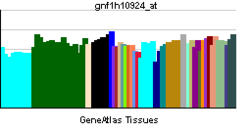- OR9A2
-
Olfactory receptor, family 9, subfamily A, member 2 Identifiers Symbols OR9A2; External IDs MGI: 3030295 HomoloGene: 83448 GeneCards: OR9A2 Gene Gene Ontology Molecular function • receptor activity
• olfactory receptor activityCellular component • plasma membrane
• integral to membraneBiological process • sensory perception of smell
• response to stimulusSources: Amigo / QuickGO RNA expression pattern 
More reference expression data Orthologs Species Human Mouse Entrez 135924 258380 Ensembl ENSG00000179468 ENSMUSG00000068259 UniProt Q8NGT5 n/a RefSeq (mRNA) NM_001001658 XM_001006837 RefSeq (protein) NP_001001658 XP_001006837 Location (UCSC) Chr 7:
142.72 – 142.72 MbChr 6:
40.47 – 40.47 MbPubMed search [1] [2] Olfactory receptor 9A2 is a protein that in humans is encoded by the OR9A2 gene.[1]
Olfactory receptors interact with odorant molecules in the nose, to initiate a neuronal response that triggers the perception of a smell. The olfactory receptor proteins are members of a large family of G-protein-coupled receptors (GPCR) arising from single coding-exon genes. Olfactory receptors share a 7-transmembrane domain structure with many neurotransmitter and hormone receptors and are responsible for the recognition and G protein-mediated transduction of odorant signals. The olfactory receptor gene family is the largest in the genome. The nomenclature assigned to the olfactory receptor genes and proteins for this organism is independent of other organisms.[1]
Contents
See also
References
Further reading
- Gilad Y, Bustamante CD, Lancet D, Pääbo S (2003). "Natural selection on the olfactory receptor gene family in humans and chimpanzees.". Am. J. Hum. Genet. 73 (3): 489–501. doi:10.1086/378132. PMC 1180675. PMID 12908129. http://www.pubmedcentral.nih.gov/articlerender.fcgi?tool=pmcentrez&artid=1180675.
- Malnic B, Godfrey PA, Buck LB (2004). "The human olfactory receptor gene family.". Proc. Natl. Acad. Sci. U.S.A. 101 (8): 2584–9. doi:10.1073/pnas.0307882100. PMC 356993. PMID 14983052. http://www.pubmedcentral.nih.gov/articlerender.fcgi?tool=pmcentrez&artid=356993.
External links
This article incorporates text from the United States National Library of Medicine, which is in the public domain.
Class II
(tetrapod specific receptors)Family 1Family 2A1 · A2 · A4 · A5 · A7 · A12 · A14 · A25 · A42 · AE1 · AG1 · AG2 · AJ1 · AK2 · AP1 · AT4 · B2 · B3 · B6 · B8 · B11 · C1 · C3 · D2 · D3 · F1 · F2 · G2 · G3 · G6 · H1 · H2 · J1 · J2 · J3 · K2 · L2 · L3 · L5 · L8 · L13 · M2 · M3 · M4 · M5 · M7 · S2 · T1 · T2 · T3 · T4 · T5 · T6 · T8 · T10 · T11 · T12 · T27 · T29 · T33 · T34 · T35 · V1 · V2 · W1 · W3 · W5 · Y1 · Z1
Family 3Family 4Family 5Family 6Family 7Family 8Family 9Family 10Family 11Family 12Family 13Categories:- Human proteins
- Transmembrane receptor stubs
- G protein coupled receptors
Wikimedia Foundation. 2010.
